Expanded Summary
(click to collapse)
(Click a title or small image to see the full-size slide)
Flexible Collaboration Transparency
Keywords: Computer-supported cooperative work, groupware, collaboration transparency, multi-user interface components, workspace awareness, Java
Types of Software for Real-time Collaboration
- Collaboration Transparency
- Single-user legacy applications shared without developer awareness. The sharing is unknown, or “transparent,” to the application.
- Examples: NetMeeting, SharedX, SharedApp, XTV
- Collaboration Awareness
- Applications designed for collaborative use
- Examples: Editors (SASSE), whiteboards, chat, multi-player games (Diablo, Doom)
- Problem
- Conventional collaboration transparency has low development cost, but provides inflexible support of collaboration
Transparency versus Awareness
Support for Collaboration
Problem of Concurrent Work
- User inputs can interleave and conflict
- Solution of conventional collaboration transparency: take turns
- but that prevents concurrent work
Sequential versus Concurrent Editing
- Sequential shared editing
- Taking turns restricts text editing to only one user at a time.
- Concurrent shared editing
- Multiple users may simultaneously edit text.
WYSIWIS and Awareness
- What You See Is What I See (WYSIWIS)
- Collaboration transparency has strict WYSIWIS
- All participants have exact same view at same time.
- Collaboration awareness relaxes WYSIWIS
- Participants have independent views of shared data.
- Allows independent simultaneous work
- Group Awareness
- Information about participants locations and activity in shared application.
 Telepointers to represent remote mouse cursors
Telepointers to represent remote mouse cursors
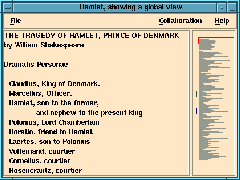 “radar” views to indicate remote scroll positions
“radar” views to indicate remote scroll positions
Centralized Architecture
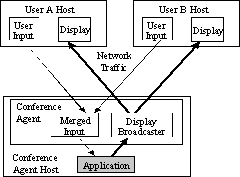
- Common to conventional collaboration transparency
- One central copy of shared application
- Graphics output sent to each remote participant
- Remote inputs merged
- Higher network traffic
Goals and Approach
- System Goals
- Lower network bandwidth requirement
- Concurrent work allowed in application
- Usage Goals
- Support multiple collaboration styles
- Relaxed What You See Is What I See (WYSIWIS)
- Detailed group awareness information
- Approach
- Replicated network architecture
- Replace single-user interface objects with multi-user equivalents
- Optimistic distributed algorithm for concurrent text editing
- Automate “turn taking” where still required
Replicated Architecture
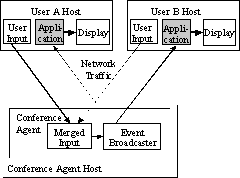
- Used by new approach
- Each person has a copy of the shared application
- Remote inputs are merged
- Lower network traffic
- Enables:
- Independent views
- Concurrent work
Object Replacement

Multi-user equivalent objects are substituted for single-user originals
JAMM (Java Applets Made Multi-user)
A single-user editor application containing a scrollable panel …
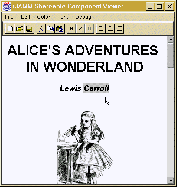
… becomes a shared editor containing a multi-user scrollable panel
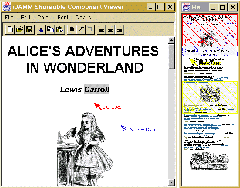
Evaluation: Improved Group Performance Time
- New system, JAMM, versus conventional, NetMeeting
- Two tasks
- Text Entry: two authors simultaneously enter text
- Copy Edit: editor leads author to make changes in a text
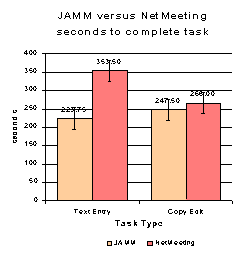
- Results
- Text Entry: less time using JAMM (223.75 seconds) than NetMeeting (353.50) (p<.001)
- Copy Edit: no difference, as expected (p = 0.7905)




 Telepointers to represent remote mouse cursors
Telepointers to represent remote mouse cursors “radar” views to indicate remote scroll positions
“radar” views to indicate remote scroll positions




